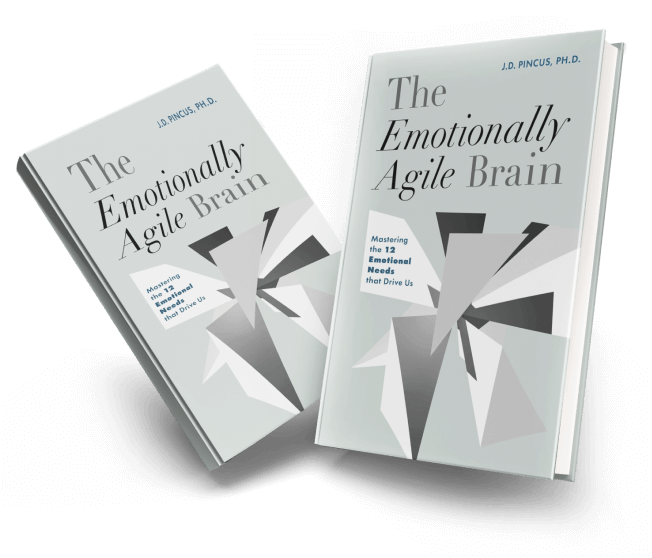Stress is a fact of life.
Whether it’s the pressure of deadlines, relationship challenges, or navigating big life transitions, stress shows up in different forms and intensities. But not all stress is bad—and when we learn to understand and work with it, we can actually use stress as a catalyst for growth.
Let’s explore how to distinguish different types of stress, why it’s crucial to name and understand our emotions in response to stress, and how AgileBrain can help us build lasting resilience.
Listen to the Podcast
HOST: Welcome to the discussion, everyone. Today we’re diving into the world of stress management and resilience building, using something called the AgileBrain exercise. Um, it promises to, uh, really transform how we handle life’s inevitable challenges.
GUEST: Exactly. Stress is unavoidable, you know? But suffering from it? That’s totally optional. AgileBrain helps us understand, um, the root causes of our stress responses.
HOST: So, it’s not just about reducing stress, but understanding it? I see.
GUEST: Precisely. It’s about identifying the underlying emotional needs that are being triggered, yeah.
HOST: Intriguing. Let’s explore how AgileBrain helps us pinpoint these needs and build resilience. Okay, let’s start with the different types of stress. You mentioned acute, chronic, and eustress. Can you elaborate a bit?
GUEST: Sure. Acute stress is short-term, like, you know, a deadline at work. Chronic stress is ongoing, like, um, financial worries or relationship problems. And eustress? That’s positive stress, like the excitement of a new project. The key is recognizing which type you’re facing, right?
HOST: So, understanding the type of stress is the first step towards managing it?
GUEST: Absolutely. It allows for a more targeted approach. For example, acute stress might need a quick relaxation technique, while chronic stress might require, um, a longer-term strategy. Makes sense, huh?
HOST: Makes sense. Let’s talk about how naming the emotion plays a role.
GUEST: Yeah, affect labeling is crucial. Naming your emotion—’I’m feeling anxious’—activates the prefrontal cortex, helping regulate the amygdala, the brain’s fear center.
HOST: How does AgileBrain fit into this picture?
GUEST: AgileBrain uses a visual map to identify your emotional state and pinpoint unmet needs. It distinguishes between Promotion needs—like wanting success—and Prevention needs—like avoiding injustice.
HOST: So, Promotion needs are about growth, while Prevention needs are about security? Right?
GUEST: Exactly. Understanding this distinction is key. Stress from pursuing a Promotion goal is different from stress caused by feeling unfairly judged. Totally different.
HOST: Can you give us some real-world examples? Let’s hear some examples of how these needs manifest in daily life.
GUEST: Okay, imagine Amara, a marketing manager excited about a product launch. Her stress is linked to a strong desire for success—a Promotion need. It’s energizing stress, you know?
HOST: And what about a Prevention need example?
GUEST: Liam, for instance. He’s feeling excluded from his partner’s social plans, and he’s experiencing stress linked to a Prevention need—inclusion. This stress is draining and demoralizing. It’s a very different feeling.
HOST: So, AgileBrain helps differentiate between these two types of stress responses?
GUEST: Yes, it helps individuals understand the source of their stress and tailor their response accordingly.
HOST: Let’s talk about resilience. How does AgileBrain help build it?
GUEST: Resilience is about bouncing back from adversity, right? AgileBrain enhances emotional awareness, allowing for more thoughtful responses to stress.
HOST: It’s not about avoiding stress, but managing it effectively?
GUEST: Precisely. It’s about developing emotional agility.
HOST: Can you outline a step-by-step guide on using AgileBrain for resilience building? Let’s break down the process. What’s the first step?
GUEST: Step one: Pause and scan your inner world. Use AgileBrain to identify and name your feelings.
HOST: And step two?
GUEST: Identify the source of the emotion. What triggered it? Was it a conversation, a memory, something else?
HOST: What about step three?
GUEST: Translate the emotion into a need. Is it a Promotion or Prevention need?
HOST: And step four?
GUEST: Choose your response. Resilience is about making conscious, values-aligned decisions.
HOST: And finally, step five?
GUEST: Reflect and rebuild your resilience skills. Learn from your experiences.
HOST: Let’s add some actionable tips to each step. For step one, what would you suggest?
GUEST: Take three minutes daily to check in with AgileBrain, name your top unmet needs.
HOST: Step two?
GUEST: Journal about the event connected to the emotion. Use prompts like “This need might be coming from…”
HOST: Step three?
GUEST: Identify if it’s a Promotion or Prevention need. Ask: What is this feeling trying to tell me?
HOST: Step four?
GUEST: Write down one small step to meet your needs. If you need connection, call a friend. Something small.
HOST: And step five?
GUEST: Use daily AgileBrain check-ins to celebrate small wins and recalibrate.
HOST: So, AgileBrain helps us transform our relationship with stress?
GUEST: Exactly. It’s about treating emotions as valuable data, turning stress into insight.
HOST: It’s about presence, not perfection. That was a great discussion! Thank you so much for sharing your insights on using AgileBrain to build resilience. It was really helpful.
Understanding Stress: The Good, the Bad, and the Chronic
Stress typically falls into three categories: Acute, Chronic & Eustress.
Understanding what kind of stress you’re experiencing is the first step toward managing it effectively. It’s not just about reducing stress but understanding its role in your life.
Why Naming the Stressor Emotion Matters
Too often, we carry stress without understanding its source. We may feel anxious or overwhelmed but can’t pinpoint why. This lack of clarity can perpetuate cycles of avoidance or self-blame. This is where affect labeling becomes essential.
Affect labeling is the process of identifying and naming your emotions—a practice that neuroscience shows can reduce the intensity of emotional experiences and help regulate the nervous system. It involves consciously recognizing and stating your feelings, such as saying to yourself, “I’m feeling unsafe,” or “I’m just excited, not angry.”
Labeling an emotion helps activate the brain’s prefrontal cortex, which plays a critical role in executive functions like decision-making and emotional regulation. Simply naming an emotion can calm the amygdala, the brain’s fear center, allowing you to regain a sense of control.
One powerful tool to aid this process is AgileBrain, an exercise grounded in neuroscience and psychology. It uses a visual map of emotional responses to help users quickly identify their current emotional state and helps them unpack the “why” that underlies their feelings. The result displays a framework of unmet emotional needs by name, allowing individuals to explore what emotions are most activated in the moment.
AgileBrain’s Promotion & Prevention Needs and Their Role in Stress
At the heart of the AgileBrain framework lies a powerful concept drawn from regulatory focus theory: Promotion and Prevention needs. These emotional needs shape our motivation, drive our behavior, and influence how we respond to stress.
Understanding this distinction is key to making sense of why some stressors feel invigorating while others feel overwhelming. For example:
- Stress that arises when you’re pursuing a Promotion goal—like preparing for a speech or training for a marathon—can feel intense but purposeful. It’s a kind of eustress, because it’s aligned with a desire for growth.
- On the other hand, stress related to a Prevention need—like being unfairly judged (Injustice) or excluded from a group (Exclusion)—can hit deeper. These experiences can erode your psychological foundation and lead to long-term emotional consequences if unaddressed. As Daniel Kahneman famously said, “Bad is stronger than good.”
AgileBrain identifies and tracks how strongly these Promotion and Prevention needs are felt in the moment. It asks participants to complete sentence prompts like: “I wish I could feel a little more ___” or “I wish I could feel a little less ___,” using emotionally resonant images. The choices reflect both the intensity and type of need—whether someone wants to amplify their sense of Purpose or reduce feelings of Disempowerment, for example.
Examples of Promotion vs. Prevention in Action
To illustrate how Promotion and Prevention needs show up in everyday life—and how they can trigger very different types of stress—here are two short examples:
By identifying which needs are being activated in a given moment, individuals gain greater awareness of the type of stress they are facing and can take targeted steps to regulate their emotional state and build resilience.
What Is Resilience and Why It Matters
Resilience is the ability to adapt and recover from adversity, challenges, or significant sources of stress. It doesn’t mean that a person doesn’t experience difficulty or distress. Rather, resilience is about how effectively you can bounce back after setbacks, learn from hardship, and continue moving forward with strength and purpose. As Charles Darwin said, “It is not the strongest of the species that survive, nor the most intelligent, but the one most responsive to change.” Resilience is another word for adaptability and flexibility in response to stress.
Building resilience doesn’t just help us survive tough times—it enhances our overall mental wellbeing, sharpens our emotional awareness, and equips us to handle life’s inevitable ups and downs with greater grace. Resilience isn’t a trait you either have or don’t have. It involves behaviors, thoughts, and actions that can be learned and developed in anyone.
Developing resilience means becoming more emotionally agile. Instead of being knocked down by stress, you’re able to regain your balance, process your emotions, and respond thoughtfully. It helps you grow stronger, more resourceful, and more connected to yourself and others.
In today’s fast-paced world, where uncertainty and change are constant, resilience isn’t a luxury—it’s a necessity. And that’s where AgileBrain comes in: to help you build those skills through self-awareness, emotional insight, and intentional practice.
Step-by-Step: Using AgileBrain to Build Resilience with Promotion & Prevention in Mind
Resilience isn’t about avoiding stress—it’s about bouncing back from it stronger and more self-aware. Building resilience means learning to navigate emotional challenges with grace, insight, and adaptability. Here’s how you can use AgileBrain insights to build real-life resilience:
Pause and Scan Your Inner World
Before reacting to stress, take a mindful pause. Intentionally create space between stimulus and response. Use AgileBrain to help you determine and name what you’re feeling. This moment of reflection helps you step out of autopilot mode.
Identify the Source of the Emotion
Once you’ve named the emotion, ask: What triggered this feeling? Was it a conversation, an expectation, a memory, or something else? Mapping this connection helps you differentiate between the emotional need and the situation, allowing more objectivity.
Translate Emotion into Need
AgileBrain maps each of our emotional needs to its energy sources in Promotion and/or Prevention. When the stressor relates to a Promotion need (want more of)—like a desire for Success or Potential—acknowledge that some pressure is normal and may even be necessary for growth. Set realistic goals and build momentum gradually.
When stress stems from a Prevention need (want less of)—like Injustice or Scorn—realize that this is your brain signaling a threat to your emotional equilibrium or core values. These stressors often require more reflection, support, and long-term attention.
Choose Your Response to the Stressor
Now that you understand the emotion and its underlying need, you can choose how to respond. Resilience is built not just in surviving stress but in making conscious, values-aligned decisions in response.
Reflect and Rebuild Your Resilience Skills
After the moment passes, reflect: What did I learn about myself? How did I manage this stress differently than in the past?
Final Thoughts: Stress as a Signal, Not the Enemy
Stress doesn’t have to be the enemy. When we learn to listen to our emotions and respond with self-awareness, we build emotional muscles that make us stronger and more adaptive. AgileBrain brings clarity to our inner world, helping us shift from reactivity to resilience.
It’s not about eliminating stress, but transforming your relationship with it. When you treat emotions as valuable data, you turn stress into insight. When you respond to those insights with care, you cultivate true resilience.
Remember: resilience isn’t about perfection—it’s about presence. It’s about showing up for yourself with curiosity, compassion, and courage, one moment at a time.











